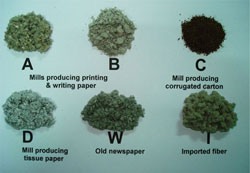Paper Mill Sludge as Fiber Additive for Asphalt Road Pavement
Erlinda L. Mari*, Ma. Salome R. Moran, and Cesar O. Austria
Forest Products Research and Development Institute
Department of Science and Technology
College, Laguna
*Corresponding author: This email address is being protected from spambots. You need JavaScript enabled to view it.

ABSTRACT
This study evaluated the properties of stone mastic asphalt mixtures made with paper mill sludge from four paper mills, as well as wastepaper, as fiber additive. Marshall specimens were prepared with asphalt content of 4.5, 5.0, 5.5, 6.0 and 6.5% and sludge or fiber contents of 0.2, 0.3, 0.4 and 0.5 percent. Properties tested were bulk specific gravity, stability, flow, air voids, voids in mineral aggregates and voids filled with asphalt. Effects of asphalt and fiber contents on flow and stability were analyzed statistically. Asphalt contents between 5 and 6 percent and sludge or fiber contents between 0.3 and 0.5% from any of the four paper mills resulted in Marshall specimens with properties generally passing the Department of Public Works and Highways specifications for both medium and heavy traffic road pavement.
INTRODUCTION
A good road is paved or covered with a structure to supplement the natural strength of the soil foundation. The pavement may either be rigid (portland cement concrete) or flexible (hot-mix asphalt) [HMA]. HMA pavements suffer damage in the form of cracks that result in high maintenance cost. These cracks are caused by any or the combination of several factors, namely: asphalt, mix, traffic, environment, pavement structure, construction, geology, and pavement design (Soupe 2001). For all types of cracks, the quality of the asphalt and the mixture used is of prime importance.
In the early 60s, Germany began developing stone mastic asphalt (SMA) for the reduction of wear caused by studded tires. SMA is a dense, gap-graded bituminous mixture with high contents of stone, filler and bitumen, modified with a suitable binder carrier such as cellulose fiber (Richardson 1999).
The cellulose fiber additive used in SMA is said to prevent drainage of asphalt binder and thus improve binding with aggregates. Such additive has been introduced in the Philippines and pilot-tested. After some years of observation, the Department of Public Works and Highways (DPWH) has released a technical report (Faustino & Valencia 2003) specifying the material and construction requirements of SMA containing fiber.
REFERENCES
[AASHTO] AMERICAN ASSOCIATION OF STATE HIGHWAY AND TRANSPORTATION OFFICIALS. 1990. American Association of State Highway and Transportation Officials. Standard Specifications for Transportation Materials and Methods of Sampling and Testing Part II Tests, 15th ed. Washington, DC: American Association of State Highway and Transportation Officials. 877p.
BROWN ER, HADDOCK JE, MALLICK RB, LYNN TA. 1997. Development of a mixture design procedure for stone matrix asphalt (SMA). NCAT Report 97-3 March 1997. Alabama: National Center for Asphalt Technology (NCAT), Auburn University. Retrieved 21 August 2007 from ntl.bts.gov/lib/3000/3900/3903/ rep97-3.pdf.
ESCOLANO JO, TAMOLANG FN. 1981. Research studies on tropical hardwoods for pulp and paper manufacture. NSDB Technology J 6(3): 27-38.
ESPILOY ZB, MORAN MSR, ESPILOY JR ER. 1999. Basic properties of two-lesser-used bamboo species: Laak [Bambusa sp.] and Kayali [Gigantochloa atter]. FPRDI Journal. 25(1 &2).
ESTUDILLO CP, VISPERAS RV, BALLON CH, TADENA OB, VILLANUEVA EP. 1972. Sulfate Pulping Studies on Yemane (Gmelina arborea Roxb.). The Philippine Lumberman 18(4).
FAUSTINO RP, VALENCIA NR. 2003. Implementing specifications of stonemastic asphalt (SMA) technology with cellulose fiber. DPWH Technical J 16: 18-24.
FERNANDEZ EC, LAMASON CRG, DELGADO TS. 2001. Housing construction material from paper mill sludge. In: Paper Sludge: A Beneficial Breakthrough. Proceedings of the 5th International Workshop on the Use of Paper Industry Sludges in Environmental GeoTechnology and Construction; 2001 May 23-25; New World Renaissance Hotel, Makati City, Philippines. I.D.E.A Ltd. Embassy of Finland, Manila: Woodfields Consultant, Inc. p. 37-49.
MOO-YOUNG HK, ZIMMIE TF. 1997. Waste minimization and re-use of paper sludges in landfill covers: A case study. Waste Management & Research 15: 593-605.
PAGBILAO DS. 2003. Asphalt Mix Design. Laboratory Manual. Manila: Integrated Research and Training Center, Technological University of the Philippines. 67p. (Available at TUP, Manila)
[RRDC] Renewable Resource Data Center. 1998. Wisconsin ethanol – Pulp & Paper Mill Wastes. Retrieved 25 February 1998 from the World Wide Web: http://www.rredc.nrel.gov/biomass/doe/rbep/ wis_ethanol/wastes.html
RICHARDSON JTG. 1999. Stone Mastic Asphalt in the UK. SCI Lecture Papers Series. Society of Chemical Industry. ISSN 1353-114X. LPS 0100/98. Retrieved 21 August 2007 from http://sci.mon.org/lps.
SJÖSTROM E. 1977. The behavior of wood polysaccharides during alkaline pulping processes. Tappi 60(9): 151-154.
[SHWEC] Solid and Hazardous Waste Education Center. 2008. Landfill. Retrieved 24 November 2008 from http://www4.uwm.edu/shwec/links/uwgb/landfill.htm
SOUPE JJ. 2001. Asphalt Pavement Distress Guide Version 2.13.2001. Cracks. Retrieved 29 July 2001 from the World Wide Web: http:www.geocities.com/ jeffjacksoupe/pavementdistress/A-cracks-html
[TAPPI] TECHNICAL ASSOCIATION OF THE PULP AND PAPER INDUSTRY. 1994. TAPPI Test Methods. Technology Park, Atlanta, Georgia, USA: TAPPI Press. 1062p.









